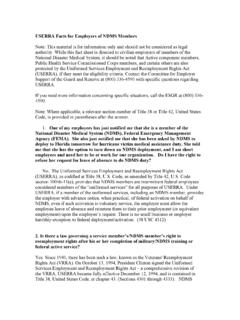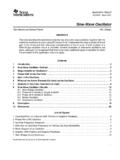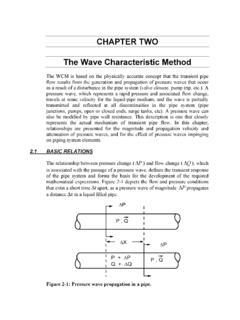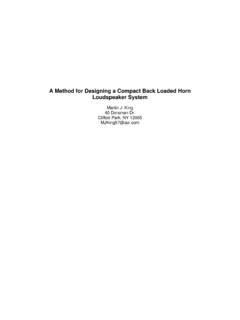Transcription of Blast Injuries ”True Weapons of Mass Destruction”
1 Blast Injuries true Weapons of mass destruction . Written for The European Master's in Disaster Medicine by Charles Stewart MD. Associate Professor of Emergency Medicine University of Oklahoma, Tulsa Director of Research Oklahoma Institute of Disaster and Emergency Medicine Charles Stewart MD Charles Stewart and Shusterman Center Associates, 2010. 4502 East 41st Street Suite 2E06 10909 S. Quebec Place Tulsa, OK 74135 Tulsa, OK 74137. Voice: 918-296-3789. Work: 918-660-2828 Cell: 918-344-4557. Fax: 918-660-3821. Document Title: Blast Injuries - 2008 Document Size: 4606 words Copyright to this work is retained by the Author, but the work may be freely copied for educational purposes Blast Injuries EMERGENCY MEDICINE PRACTICE. Figure 1 Suicide bomber vest The typical vest-borne Weapons of a suicide-bomber. Picture from accessed 20 October 2003. Abbreviations used in this article AGE Arterial gas embolism ANFO Ammonium Nitrate Fuel Oil explosive compound ATF Alcohol, Tobacco and Firearms BLEVE Boiling Liquid Expanding Vapor Explosion CT Computerized tomography C4 Composition C-4 explosive FBI Federal Bureau of Investigation GI gastrointestinal tract HE High order explosive LE Low order explosive Page 2 of 79 pages Blast Injuries EMERGENCY MEDICINE PRACTICE.
2 PETN - Pentaerythritol Tetranitrate (explosive compound). RDX - Royal Demolition explosive TATP triacetone triperoxide (also called TCAP or acetone peroxide) non- nitrate high explosive TM tympanic membrane TNT tri-nitro-toluene (explosive compound). WWI World War I. WWII World War II. Introduction Prior to 1995, in the United States, most civilian emergency physicians had neither experience nor interest in the effects of explosive devices. This abruptly changed with the destruction of the Alfred P. Murrah Federal building by a truck bomb in downtown Oklahoma City in 1995 resulted in more than 750 casualties with 167 fatalities. 1 Unfortunately, many smaller devices are exploded each year in the United 3 4 As we reluctantly continue to mourn the World Trade Center collapse on 9/11/2001 and events resulting from our invasion of Iraq and Afghanistan, more United States physicians have been forced to consider that they, too, may face the specter of explosions and Blast Injuries due to 6 The July 7, 2005 London and the March 11, 2004 Madrid bombings have forced physicians in other countries to consider or reconsider their potential roles in explosions and Blast Injuries due to terrorism.
3 Page 3 of 79 pages Blast Injuries EMERGENCY MEDICINE PRACTICE. Bombings are clearly the most common cause of casualties in terrorist Recent terrorism has included an increasing use of suicidal/homicidal bombers that deliberately accompany the explosive device (often wearing it) to ensure that the maximum effect is derived from the explosive These bombers have walked or driven into buses, subways, cafes, residential areas, guard-posts, and governmental buildings. The use of these suicide devices in the United States has not yet occurred, but given the political climate, is very likely. The emergency physician is increasingly likely to see the effects of these devices. Increasingly, information resources such as the internet, terrorist training camps, and even library and television sources have made readily available the knowledge needed to construct these simple and very effective explosive devices.
4 The threat of delivered explosives is not confined to mail rooms or government facilities. A substantial number of explosive devices have been placed in academic facilities and in public parks during events. 6 9. Page 4 of 79 pages Blast Injuries EMERGENCY MEDICINE PRACTICE. Academic Private facilities residence 4% 8%. Open areas 10%. Vehicles 12%. Mailboxes /. Other private Commercial property property 42%. 11%. Government property All others 5% 8%. Figure 2 Historic location of United States Bomb Incidents This article will review the current literature about Blast Injuries . The potential mechanisms of injury, early signs of these Injuries , and the natural course of the problems caused by explosive blasts will be discussed. Investigation about Blast injury is not a new study for those interested in combat medicine. Our present knowledge of the effects of Blast injury date back to the Balkan wars in 1914 when Franchino Rusca, a Swiss researcher, observed that three soldiers who had been killed by an explosion without evidence of any external He went on to use rabbits as an animal model and demonstrated that the cause of death was pulmonary embolism.
5 During WWI, Page 5 of 79 pages Blast Injuries EMERGENCY MEDICINE PRACTICE. Blast injury was thought to be a nervous system disorder and labeled shell- shock. (Psychological casualties were lumped together with those who had no visible Injuries .)11. In WWII, a noteworthy number of casualties were found among civilians in both German and British cities after bombing raids. Blast lung was coined for massive pulmonary hemorrhage from disruption of the alveolar architecture and formation of alveolar-venous fistulas resulting in air Following WWII, nuclear weapon Blast injury was intensively investigated in the USA. Only since the onset of terrorist suicide bombings have civilians been significantly concerned about the cause and treatment of Blast Critical Appraisal of the Literature The literature of Blast Injuries is replete with case reports, data-mining from trauma registries and retrospective reviews.
6 There are few meta-analyses and even fewer prospective studies. Part of this is due to the nature of the injury: sudden, random, and unpredictable. Another part is due to the dispersion in both time and space of the Injuries . Although recent bombings have had wide- spread effect, they simply don't occur in the same location enough to start a randomized study of any treatment methodology. The possible exceptions to this are in the Middle East, specifically Israel and our military in Iraq. Much of the case reports cited in this article are from researchers in Israel and the military. Page 6 of 79 pages Blast Injuries EMERGENCY MEDICINE PRACTICE. Epidemiology, Etiology, Pathophysiology An explosion is an event that occurs when a substance rapidly releases energy and produces a large volume of gaseous products. High explosive, thermobaric, and nuclear detonations all provide this change in potential energy to kinetic injury in a very short period of time.
7 The extreme compression of molecules by this change in energy creates bands of locally high pressure, the Blast wave which moves outwards from the epicenter of the Blast . These Blast waves travel faster than the speed of sound. Blast products gas, particles, and debris of the container and items in proximity to the explosive (including human remains) also spread outwards, but travel much more slowly. Both the Blast wave and the Blast products can cause Injuries as described below. Trauma caused by explosions traditionally has been divided into the injury caused by the direct effect of the Blast wave (primary Injuries ); the effects caused by other objects that are accelerated by the explosive wave, (secondary Injuries ); the effects caused by movement of the victim (tertiary Injuries ); and miscellaneous effects caused by the explosion or explosives. The injury pattern following an explosion is partly random.
8 Explosions have the potential to cause multi-system Injuries involving multiple patients simultaneously. The trauma that results from an explosion depends on the combination of the size of the explosive charge, the composition and nature of the explosive, the container and surrounding or contained items, any shielding or protective barriers between the victim and the explosion, the surrounding Page 7 of 79 pages Blast Injuries EMERGENCY MEDICINE PRACTICE. environment, the method of delivery, and the distance between the explosion and the victim. Illustration by Charles Stewart MD. Figure 3 Illustration of primary, secondary, and tertiary injury from Blast Nature of explosives A conventional explosion is the rapid chemical conversion of a solid or liquid into gas. Thermobaric explosives (commonly called fuel-air explosives). are either gases mixed with air or finely divided particles or droplets suspended in air.
9 Explosives are categorized as High-order Explosives or Low-order Explosives. HE and LE cause somewhat different injury patterns. Nuclear explosive effects will not be discussed in this article. Page 8 of 79 pages Blast Injuries EMERGENCY MEDICINE PRACTICE. High order explosives High explosives are chemical materials that have an extremely high reaction rate. This reaction is often called a detonation. Examples of high explosives include nitroglycerine, dynamite, C-4, picric acid, Semtex, nitroglycerin, dynamite, ammonium nitrate fuel oil mixture (ANFO), TNT, PETN. and TATP (triacetone triperoxide non-nitrate high explosive). When a high explosive detonates, it is converted almost instantaneously into a gas at very high pressure and temperature. For example the major ingredient in Composition C4 (Cyclotrimethylenetrinitramine or RDX [Royal Demolition eXplosive]) can generate an initial pressure of over 4 million pounds per square inch (4x10E6 PSI).
10 13 These high pressure gases rapidly expand from the original volume and generate a marked pressure wave the Blast wave . that moves outward in all directions. The result is a sudden shattering blow on the immediate surroundings. High explosives are further categorized as primary and secondary high explosives. The primary high explosive is very sensitive, can be detonated very easily and generally is used only in primary and electrical detonators. Secondary high explosives are less sensitive, require a high energy shock wave to achieve detonation and are generally safer to handle. The Blast wave refers to an intense rise in pressure often called over pressure that is created by the detonation of a high A typical pressure wave from a high explosive explosion in air is shown in the diagram Page 9 of 79 pages Blast Injuries EMERGENCY MEDICINE PRACTICE. below.








